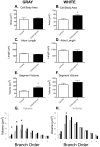Neuropathogenesis of Chikungunya infection: astrogliosis and innate immune activation
- PMID: 26419894
- PMCID: PMC4783292
- DOI: 10.1007/s13365-015-0378-3
Neuropathogenesis of Chikungunya infection: astrogliosis and innate immune activation
Abstract
Chikungunya, "that which bends up" in the Makonde dialect, is an emerging global health threat, with increasing incidence of neurological complications. Until 2013, Chikungunya infection had been largely restricted to East Africa and the Indian Ocean, with cases within the USA reported to be from foreign travel. However, in 2014, over 1 million suspected cases were reported in the Americas, and a recently infected human could serve as an unwitting reservoir for the virus resulting in an epidemic in the continental USA. Chikungunya infection is increasingly being associated with neurological sequelae. In this study, we sought to understand the role of astrocytes in the neuropathogenesis of Chikungunya infection. Even after virus has been cleared form the circulation, astrocytes were activated with regard to TLR2 expression. In addition, white matter astrocytes were hypertrophic, with increased arbor volume in gray matter astrocytes. Combined, these would alter the number and distribution of synapses that each astrocyte would be capable of forming. These results provide the first evidence that Chikungunya infection induces morphometric and innate immune activation of astrocytes in vivo. Perturbed glia-neuron signaling could be a major driving factor in the development of Chikungunya-associated neuropathology.
Keywords: Alphavirus; Chikungunya; Gliosis; Morphometry; Togavirus; Toll-like receptor.
Figures




References
-
- Abbott NJ, Ronnback L, Hansson E. Astrocyte-endothelial interactions at the blood-brain barrier. Nat Rev Neurosci. 2006;7(1):41–53. - PubMed
-
- Allaire PD, Seyed Sadr M, Chaineau M, Seyed Sadr E, Konefal S, Fotouhi M, Maret D, Ritter B, Del Maestro RF, McPherson PS. Interplay between Rab35 and Arf6 controls cargo recycling to coordinate cell adhesion and migration. J Cell Sci. 2013;126:722–731. Pt 3. doi:10.1242/jcs.112375. - PubMed
-
- Arpino C, Curatolo P, Rezza G. Chikungunya and the nervous system: what we do and do not know. Reviews in medical virology. 2009;19(3):121–129. doi:10.1002/rmv.606. - PubMed
-
- Chhabra M, Mittal V, Bhattacharya D, Rana U, Lal S. Chikungunya fever: a re-emerging viral infection. Indian journal of medical microbiology. 2008;26(1):5–12. - PubMed
Publication types
MeSH terms
Substances
Grants and funding
LinkOut - more resources
Full Text Sources
Other Literature Sources
Medical

